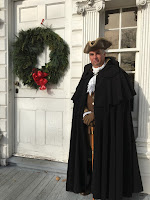
Decorating for many includes trees
and greenery, baubles, fruit, and shiny things of every shape and size, perhaps
some candles and even decorated plates and cups. The people who observed Christmas
in the late 18th century, had a very different relationship
with the holiday, quite contrary to today’s ideas on Christmas and how we
decorate and celebrate it.
We know that a Colonial Christmas varied
from one British colony to another. According to the folks at the Norfolk Town Assembly,
“In New England, Christmas celebrations were illegal during parts of the 17th
century and were culturally taboo or rare in former Puritan colonies from
foundation until the mid-18th century.” [1] However, it seems the further south one went, the more the
celebrating increased, Morristown National Historical Park states "...down
in Jamestown, Virginia the Englishman John Smith noted a very merry celebration
held by the settlers. Christmas in colonial times was kept – or not kept –
according to one’s religious background and country of origin. “ [2]
George
Washington’s Mount Vernon website sums it up by saying, “In the 18th century,
Christmas was primarily a religious holiday marked by parties and visits from
friends and relatives. There was little decoration. Rather, Americans expressed
their holiday spirit through the abundance of their tables and increased prayer
and contemplation.”[3]
With the advent of our historic
furnishing report, we began thinking about where the colony of New Jersey fit with
its late 18th century Christmas traditions, and whether our
decorating traditions at the Ford Mansion in particular, were true to that
period. We began researching, trying to find an accurate representation
of a bygone celebration, or perhaps even lack thereof.
Mount Vernon’s, website has some insight into what
Washington was doing the Christmas he spent here in Morristown in 1779. “On Christmas Day, George Washington paid £15 ‘for
a band of music.’ A few days later, he attended ‘the celebration of the
festival of St. John the Evangelist by the American Union Lodge of Ancient Free
and Accepted Masons.’ “ [4] Citizens of many of the colonies still held
to the British celebration of Twelfth Night or the Twelve Days of Christmas.
Norfolk Town assembly explains, “December 25, with its Christmas feast, began a
festive season that lasted well into January. The twelve days of Christmas, the
season of parties, balls, festive dinners, and other holiday merry making,
began on December 26th and lasted until January 6, also called Twelfth Day or
Epiphany.[5]

Colonial Williamsburg is often the default image of 18th century Christmas décor. There you can find wreaths and evergreen branches adorned with food, fruit, and flowers, even seashells. According to Katlin Hill from the This Old House website, “The elaborate designs wouldn't have been seen in the 18th century—historical documents suggest that holiday decorations, if any, were minimal. But in order to create a festive experience for a 21st-century audience, the team sources items that would have been familiar to the people of the period…”[6] Colonial Williamsburg curator Carl Childs said they are very open that their wreath tradition dates back to 1934 and not the 18th Century. It is a sort of "compromise" of modern decorating expectations and items that would have been available during the 18th century. [7]
What would Theodosia Ford’s mansion have looked like when the Washingtons, et al. lived there during the Christmas holiday?
There is very little primary source material suggesting that the season was the decorating extravaganza that we see today. Morristown NHP is currently working on a historic furnishing plan we hope will give a more accurate and inclusive look into the dynamics of privilege and power represented in the Colonial home. This will include depictions of how enslaved people, who were part and parcel to the operations in and around the Ford Mansion celebrated and decorated for [or did not] the holiday, or if they were afforded that liberty at all. Stay tuned.
[1] Norfolk Town Assembly staff. Holiday Traditions in Colonial America. 12 December 2021. <https://www.norfolktowneassembly.org/post/holiday-traditions-in-colonial-america-and-the-early-republic>.
[2] Morristown National Historical Park
staff. Sing We all Merrily: A Colonial Christmas. 13 December 2021
< https://www.nps.gov/morr/learn/news/colonial-christmas-concert.htm>.
[3] George Washington’s Mount Vernon staff. How Mount Vernon Decorates for Christmas. 20 December 2021.<https://www.mountvernon.org/blog/2018/12/how-mount-vernon-decorates-for-christmas>
[4] George
Washington’s Mount Vernon staff. George Washington at Christmas-1779. 13
December 2021. <https://www.mountvernon.org/the-estate-gardens/mount-vernon-christmas/george-washington-at-christmas/ >
[5] Norfolk Town Assembly staff. Holiday Traditions in Colonial America. 12 December 2021. <https://www.norfolktowneassembly.org/post/holiday-traditions-in-colonial-america-and-the-early-republic>
[6] George
Washington’s Mount Vernon staff. How Mount Vernon Decorates for Christmas. 20
December 2021.
<https://www.mountvernon.org/blog/2018/12/how-mount-vernon-decorates-for-christmas>
[7] Koncius, Jura. The history of Williamsburg’s Beloved (but not so Colonial) Holiday Decorations. 20 December 2017. <https://www.washingtonpost.com/lifestyle/home/the-history-of-williamsburgs-beloved-but-not-very-colonial-holiday-decorations/2017/12/19/0e24a5fe-c59d-11e7-aae0-cb18a8c29c65_story.html>
[8] Hill, Katelin. The Wreaths of Colonial Williamsburg.
21 December 2021.
<
https://www.thisoldhouse.com/21017910/the-wreaths-of-colonial-williamsburg>.
Blog post by Holly Marino, Museum Specialist Detailee




No comments:
Post a Comment